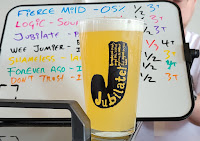 The pace may have slowed, but enough beer featuring the DOT Brew name is being turned out to get it the occasional dedicated blog post. Here's the latest, with five new ones which landed over the past few months.
The pace may have slowed, but enough beer featuring the DOT Brew name is being turned out to get it the occasional dedicated blog post. Here's the latest, with five new ones which landed over the past few months.The first is Spin Off Series NEIPA, part of the sequence of beers DOT makes for Aldi. It's not the densest of haze, looking a little thin and vapid as it poured. The aroma tells you it's no milquetoast, though, delivering what I interpret as a west-coast vibe of dank resin and sharp grapefruit. No complaints about that. The flavour brings us back to the eastern seaboard, with a soft vanilla and apricot effect, aided by a full and soft texture. There are no sharp edges here. The finish is quick, though, and I feel that a beer in this style, and of 5.8% ABV, should have longer legs. There's also an oddly savoury off flavour lurking in the background: a bit smoky, and a bit onion-ish, but nothing good and I'm reasonably sure it shouldn't be there. Still, at the sub-€3 price point, you get a decent hazy IPA. Don't scrutinise it too closely and you'll enjoy it. It's too late for me. Save yourselves.
 I trundled along to UnderDog a few weeks ago where a tap takeover was under way, and two further new IPAs were pouring. I started on Levitation, a 6% ABV job which is a medium hazy orange colour. I don't have the hop information to hand, and I'm not even sure they've been published, but whatever they are, they work brilliantly. Both the aroma and flavour have a fabulous sweet and zesty character, exactly like freshly squeezed orange juice. While that makes it a little one-dimensional, it is highly enjoyable. It's almost a shame that the ABV is so high, because it slips back with indecent ease; at once satisfying and refreshing. Complexity doesn't really feature, although I did find a little bit of spicy grapefruit peel lurking in amongst the jaffa segments. It remains to be seen whether the brightness and freshness on display in UnderDog will last if they decide to can it, but I've had my fun, and that's all that matters.
I trundled along to UnderDog a few weeks ago where a tap takeover was under way, and two further new IPAs were pouring. I started on Levitation, a 6% ABV job which is a medium hazy orange colour. I don't have the hop information to hand, and I'm not even sure they've been published, but whatever they are, they work brilliantly. Both the aroma and flavour have a fabulous sweet and zesty character, exactly like freshly squeezed orange juice. While that makes it a little one-dimensional, it is highly enjoyable. It's almost a shame that the ABV is so high, because it slips back with indecent ease; at once satisfying and refreshing. Complexity doesn't really feature, although I did find a little bit of spicy grapefruit peel lurking in amongst the jaffa segments. It remains to be seen whether the brightness and freshness on display in UnderDog will last if they decide to can it, but I've had my fun, and that's all that matters. Next, the grandly titled IPA IPA Reborn, created especially for the Craft Central off licence, and a 6.5% ABV reboot of a 7% ABV IPA that they made back in 2020. I didn't like that one and I didn't like this either. The dirty dark orange colour hinted at oxidation, the beer itself resembling carrot juice in a most unattractive way. Last time round, hot garlic was the problem, mixing badly with plastic and vanilla in a worst-of-everything take on hazy IPA. This one draws on a different set of common flaws, tasting gritty and savoury, with a harshly bittersweet marmalade tang being its only fruity feature. I don't think it was actually oxidised, but it was far from clean; too murky-tasting to be any way enjoyable. If you liked the original then maybe you should pick up a can of this as well. I can't recommend it, however.
Next, the grandly titled IPA IPA Reborn, created especially for the Craft Central off licence, and a 6.5% ABV reboot of a 7% ABV IPA that they made back in 2020. I didn't like that one and I didn't like this either. The dirty dark orange colour hinted at oxidation, the beer itself resembling carrot juice in a most unattractive way. Last time round, hot garlic was the problem, mixing badly with plastic and vanilla in a worst-of-everything take on hazy IPA. This one draws on a different set of common flaws, tasting gritty and savoury, with a harshly bittersweet marmalade tang being its only fruity feature. I don't think it was actually oxidised, but it was far from clean; too murky-tasting to be any way enjoyable. If you liked the original then maybe you should pick up a can of this as well. I can't recommend it, however.Perhaps it's a signifier of contract brewing that these were so wildly different from each other, though alas I have no way of knowing which was brewed where. Whoever was responsible for Levitation can take a bow, but I will be keeping any third version of IPA IPA at arm's length.
 DOT also makes barrel-aged beers, though it has taken some time and effort to hunt any down lately. First up, though, is To Ten and Beyond, marking ten years of Dublin's Teeling Distillery (est. 1782) and one of the regular specials DOT makes for the giftshop. As with many of the series, it's a barrel-aged pale lager, this time matured in single-grain ex-red-wine casks. There's certainly a fruity element to the aroma, though all about macerated grapes, not wonky fermentation, I'm happy to report. A cleanly crisp lager is still discernible beneath. And that's all the flavour really does. I had anticipated a little bit of whiskey, wine or raw oak, but instead it's almost purely dry to the point of being a little papery. "Hop forward" says the label, and I do get a certain Saaz-like grass note, although that does little to soften it. The finish is mineral-like: a kick of zinc and chalk. I guess it does have a few extra dimensions than your ordinary 4.8% ABV pils, and the aroma is good fun, but I didn't really get it otherwise. Happy birthday Teeling; enjoy my €6.
DOT also makes barrel-aged beers, though it has taken some time and effort to hunt any down lately. First up, though, is To Ten and Beyond, marking ten years of Dublin's Teeling Distillery (est. 1782) and one of the regular specials DOT makes for the giftshop. As with many of the series, it's a barrel-aged pale lager, this time matured in single-grain ex-red-wine casks. There's certainly a fruity element to the aroma, though all about macerated grapes, not wonky fermentation, I'm happy to report. A cleanly crisp lager is still discernible beneath. And that's all the flavour really does. I had anticipated a little bit of whiskey, wine or raw oak, but instead it's almost purely dry to the point of being a little papery. "Hop forward" says the label, and I do get a certain Saaz-like grass note, although that does little to soften it. The finish is mineral-like: a kick of zinc and chalk. I guess it does have a few extra dimensions than your ordinary 4.8% ABV pils, and the aroma is good fun, but I didn't really get it otherwise. Happy birthday Teeling; enjoy my €6. Finally, here's the twentieth version of Rum Red Dark, the perennial barrel-aged strong red ale. This time it's 9.5% ABV and claiming to be "the boldest red in the series so far". Oo-er. It's the same murky dun colour as all the rest, and smells of warm oak and sunny rum cocktails. The wood is right at the fore of the flavour, given a slightly burnt and smoky cast, though more caramelised sugar and glazed brisket than anything unpleasantly kippery. There's a separate sticky-sweet summer fruit jam element, running in parallel to the smoky wood, and an immediate boozy heat that grows steadily in the belly with each successive sip. I drank it outside on a warm evening, but it's is very much a winter beer, and an enjoyable one. I particularly commend how it melds the sticky red malt side with the barrels and booze, keeping everything smooth and sippable, even if balance isn't a concern, exactly. This is worth picking up at your leisure, but don't be in a rush to drink it.
Finally, here's the twentieth version of Rum Red Dark, the perennial barrel-aged strong red ale. This time it's 9.5% ABV and claiming to be "the boldest red in the series so far". Oo-er. It's the same murky dun colour as all the rest, and smells of warm oak and sunny rum cocktails. The wood is right at the fore of the flavour, given a slightly burnt and smoky cast, though more caramelised sugar and glazed brisket than anything unpleasantly kippery. There's a separate sticky-sweet summer fruit jam element, running in parallel to the smoky wood, and an immediate boozy heat that grows steadily in the belly with each successive sip. I drank it outside on a warm evening, but it's is very much a winter beer, and an enjoyable one. I particularly commend how it melds the sticky red malt side with the barrels and booze, keeping everything smooth and sippable, even if balance isn't a concern, exactly. This is worth picking up at your leisure, but don't be in a rush to drink it.While I prefer to see DOT releasing the barrel-aged blends, the fact that my favourite of this set was a straight IPA shows that they're fully justified in doing the less involved recipes too. Good beer is good beer, regardless of the producer's ethos or tendencies.



















































